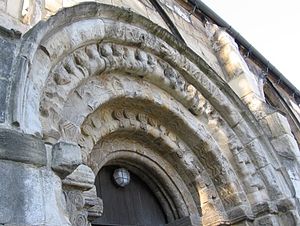Order (mouldings)
Look at other dictionaries:
Classical order — An illustration of the five orders engraved for the Encyclopédie, vol. 18, showing the Tuscan and Doric orders (top row); two versions of the Ionic order (center row); Corinthian and Composite orders (bottom row). A classical order is one of the… … Wikipedia
Romanesque architecture — is the term that is used to describe the architecture of Middle Ages Europe which evolved into the Gothic style beginning in the 12th century. The term Romanesque , meaning descended from Roman , was used to describe the style from the early 19th … Wikipedia
History of wood carving — From the remotest ages the decoration of wood has been a foremost art. The tendency of human nature has always been to ornament every article in use. The North American Indian carves his wooden fish hook or his pipe stem just as the Polynesian… … Wikipedia
10 Downing Street — Number 10 Downing Street General information Town or city City of Westminster, London Country United Kin … Wikipedia
Markandeshwar Siva Temple — Markandesvara Siva Temple … Wikipedia
Renaissance architecture — Tempietto di San Pietro in Montorio, Rome, 1502, by Bramante. This small temple marks the place where St Peter was put to death … Wikipedia
Gothic architecture — See also: Gothic art The western façade of Reims Cathedral, France … Wikipedia
Gothic Architecture — • History of the style Catholic Encyclopedia. Kevin Knight. 2006. Gothic Architecture Gothic Architecture † … Catholic encyclopedia
Molding (decorative) — For other uses, see Molding (disambiguation). Cavetto molding and resulting shadow pattern Ovolo molding and resulting shadow pattern … Wikipedia
Polyoxymethylene — Other names Poly(oxymethylene) glycol; Polymethylene glycol … Wikipedia

